
Getting Exiled with My Chivalric Bromance
This feature is a reprint from Unwinnable Monthly #170. If you like what you see, grab the magazine for less than ten dollars, or subscribe and get all future magazines for half price.
———
This series of articles is made possible through the generous sponsorship of Exalted Funeral. While Exalted Funeral puts us in touch with our subjects, they have no input or approval in the final story.

From initially dabbling in writing and editing for games as a freelancer for the original White Wolf Publishing, to starting R. Rook Studio in 2019, Richard Ruane has crafted a number of games, including Barrow Keep (nominated for an Indie Game Developer Network Groundbreaker award), the Ennie-winning Moonlight on Roseville Beach and Sherwood. The latter ended up contributing to the development of another game, the tongue-in-cheek My Chivalric Bromance. While its title is a tribute to and parody of the classic New Jersey emo band My Chemical Romance, the game’s roots dig down through medieval history.
“As part of my research for the game Sherwood, I’d read a lot of Middle English chivalric romances that are sometimes grouped in the outlaw tradition, sometimes clustered together as ‘exile romances,’” Ruane explains. “They [differ] from the better-known Arthurian romances because instead of focusing on knights going on quests or pursuing courtly love, they focus on the experience of living in exile from a homeland (AKA England).”
Ruane wanted to develop an adventure-focused game highlighting this facet of the chivalric romance tradition. In terms of gameplay mechanics, he also wanted a game without stats but remained compatible with classic adventures.
“My friends Markus Linderum and Tony Vasinda had done something similar with Down We Go and Through the Void, creating adventure-focused games that relied entirely on class and level, but I wanted to experiment with replacing stats entirely with tags,” Ruane shares. “I’d initially put together a d20-based game that counted relevant tags and added them to a die roll, but when I started working with Exalted Funeral to publish the game, I decided to shift to a d6 pool system in the spirit of LUMEN SRD and Blades in the Dark.”

This originally started coming together for the OSR June Jam hosted by Monkey’s Paw Games in 2022. “So [My Chivalric Bromance] was developed entirely for the jam, though several of the systems were things I’d experimented with or pulled from other games I’d written,” Ruane says. “Because I’d done a lot of the ‘lore’ research for Sherwood and was using mechanics that had seen a lot of testing, I was able to work pretty quickly. I briefly experimented with a magic class, but opted to focus instead on just the knight and the squire.”
The knight and squire in exile are central to My Chivalric Bromance, queer companions united in their wandering but containing multitudes in their thirst levels. “What we call ‘thirst’ – a strong, possibly overwhelming, sense of attraction – is important to a lot of medieval romances, especially those from England in the High Middle Ages,” Ruane shares. “I had the idea for an alignment based on attractions rather than morality, and wanted it to be freewheeling and fun, that left room for all kinds of players and that GMs could easily improvise with.”
In the core rulebook, guidelines for “Thirst Alignment” feature different types of interpersonal dynamics, ranging from sexual to asexual, from romantic to aromantic (and it is, in fact, chill with players possibly making heterosexual, cisgender exiles). The book also states that “Thirst Alignment may expand, narrow, or just clarify as you play the game,” making space for fluidity and change. Ruane added that once he had written that section and ran it for a medievalist specializing in chivalric romances, he read The Elusive Shift and realized that some of the early D&D-focused zine writers in the ‘70s played with similar ideas, like having players randomly generate their character’s sex and sexuality at the start of the game.
Likely as another aspect of relationships, character communication is also highlighted in gameplay, particularly with the mechanic for “Honest Answers.”

“I’m not a fan of dice-rolling for social situations, but I know there are several times players and GMs need help determining what NPCs will say and do next. My friend Ethan Harvey noted that the only social mechanics they really liked in most adventure games were those that helped them determine when an NPC was telling the truth,” Ruane says. “Rather than try to create a ‘Detect Lies’ skill, I tried to pull from the contemporary romance tradition and give PCs a chance to just demand honest answers under specific conditions.”
Some of those conditions include asking someone your character saves after a fight to just speak plainly. It’s an interesting detail merging emotional narrative and gameplay. You’ve probably seen it before somewhere in a story on screen or on the page – high emotions after a crisis facilitating more free communication between characters in the heat of the moment. Characters that weren’t ready to truly talk before, only to have peril draw them closer and prove each other dependable as confidants. If you can trust them with your life, you can probably trust them with the truth. Or perhaps there are other circumstances involved, like the new severity of a situation makes obfuscating facts no longer viable. My Chivalric Bromance seems like it could be open to that and more, able to spark and reinforce such narrative high points in play.
“The exile romances are the biggest influence,” Ruane says, naming Gamelyn, Fulk FitzWarin, Hereward the Wake and, to a lesser extent, Eustace the Monk. Working on Sherwood also involved reading several medieval romances about exiles. Ruane explains that these exiles often ended up living as outlaws, as well as associated with more popular outlaw stories like Robin Hood. He lists important resources for that included Lesley Coote’s Storyworlds of Robin Hood and Stephen Knight’s Robin Hood: A Mythic Biography, texts and commentaries collected online at Robbins Library at the University of Rochester, and translations and commentaries in Medieval Outlaws: Twelve Tales in Modern English Translation edited by Thomas Ohlgren and company. My Chivalric Bromance even incorporated historical research with the Roe Dragon described in the book’s “Bestiary.”
“Much of the Robin Hood tradition and other medieval exile/outlaw traditions is about forestry and hunting rights, so I’d spent a little time researching common animals that kings and aristocrats often protected under game laws,” Ruane explains. “While the roe deer – a small deer species that rarely gets much larger than 4′ long – are fairly common in Europe, they’re a strange concept to Americans who are used to North American white-tailed deer. D&D-style games have often contemplated smaller, less majestic species of dragons, so I proposed one of my own.”

Queer romantic fantasy and fantasy romances like TJ Klune’s Verania series and A. H. Lee’s The Knight and the Necromancer series were additional literary influences on My Chivalric Bromance. “I’d been reading so many contemporary fantasy romances and medieval chivalric romances, so I knew I wanted to call it Chivalric Bromance,” Ruane shares. “But I completely missed the parallel to the band name. I owe that to an incredible Brazilian game designer, Wendi Yu. Once she pointed that out to me, I changed the title and never looked back.”
In the realm of games, Ruane adds that he was most inspired by City of Mist, John Harper’s Blades in the Dark and Spencer Campbell’s LUMEN SRD. He further breaks down his influences, citing that the concept of that Knight as its own class in My Chivalric Bromance drew a lot from Old-School Essentials Advanced Fantasy, while rules for the Squire class gathered inspiration from the Brave class in Christian Mehrstam’s Whitehack.
“One of my goals was to create a game that would [work] well for my favorite OSR ‘talking dungeons,’ including the great Jennell Jaquays’s The Caverns of Thracia and Hydra Cooperative’s Slumbering Ursine Dunes,” Ruane says. He even used the first level of The Caverns of Thracia to run a game of My Chivalric Bromance while showcasing it at PAX Unplugged.
Swapping a more traditional experience point system for a mechanic called “Stories and Secrets” was inspired by another game. “I loved the advancement mechanics for the second edition of The Black Hack, requiring PCs to recount their adventures,” Ruane shares. “This was very much my take on that for a slightly more focused adventure game.”
The game’s story starts with knights and squires in exile. But it doesn’t have to stay that way, at least with squires. The book has a system in place where through trial and error, growth and progress, a squire can be knighted. Like the relationships, emotions, and different thirsts My Chivalric Bromance seeks to bring to the table in all their mutable layers, the squire can grow through these experiences. Through chivalric bromance, the squire can become a knight.
* * *
Buy My Chivalric Bromance at Exalted Funeral now!
———
Alyssa Wejebe is a writer and editor specializing in the wide world of arts and entertainment. She has worked in pop culture journalism and in the localization of Japanese light novels. You can find her on Twitter @alyssawejebe.




